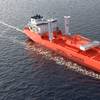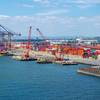Panama Canal Water Supply Study Underway
A feasibility study to safeguard Panama Canal water supplies into the 21st century is under way, the waterway's project manager said. "Studies of potential water projects are expected to take about 18 months," Panama Canal Commission's (PCC) Augustin Arias said, adding that actual development would take between and eight and 10 years.
At the end of August, Panama's Legislative Assembly passed a law extending the current canal watershed by more than 60 percent to 213 sq. miles (553 sq. km), in anticipation of increased water demands. The canal, which handled 13,137 vessel transits and generated $569 million in tolls in fiscal 1999, relies on a constant supply of fresh water to operate three flights of gravity-fed locks. The newly designated "Western Watershed" covers an 82 sq. mile (213 sq. km) highland area of Panama, Colon and Cocle provinces.
Favored proposals under consideration by PCC project planners -- selected from 33 submissions -- involve the construction of three artificial reservoirs, increasing canal water storage capacity by up to 600 percent, Arias said.
The reservoirs, covering an area of 82 square miles (447 square kms), would be linked to existing canal reservoirs by three large-diameter pipelines of between three miles (five km) and 11 miles (18 km) in length. Two hydroelectric dams across the Western Watershed's Indio and Cocle del Norte rivers -- proposed as an integral part of reservoir construction -- would contribute an estimated 200 megawatts to the national power grid.
"We are putting a lot of emphasis on the social, economic and environmental aspects of these projects, but so far the economics and engineering look good," Arias said, adding that the plan would involve the relocation of 8,500 watershed residents. Demand for fresh water is expected to grow in the next century as vessel transits increase from a current daily average of 37, to a projected 42, by 2010. Further demands will be placed on the present watershed by the needs of Panama City's growing population. "We presently provide 95 percent of the raw water for 1.4 million people in Panama City, Colon, Araijan and Chorera. Over the next 30 years that is going to double," Arias said, adding that daily metropolitan water consumption was equivalent to four ship transits.
Subscribe for
Maritime Reporter E-News
Maritime Reporter E-News is the maritime industry's largest circulation and most authoritative ENews Service, delivered to your Email five times per week









